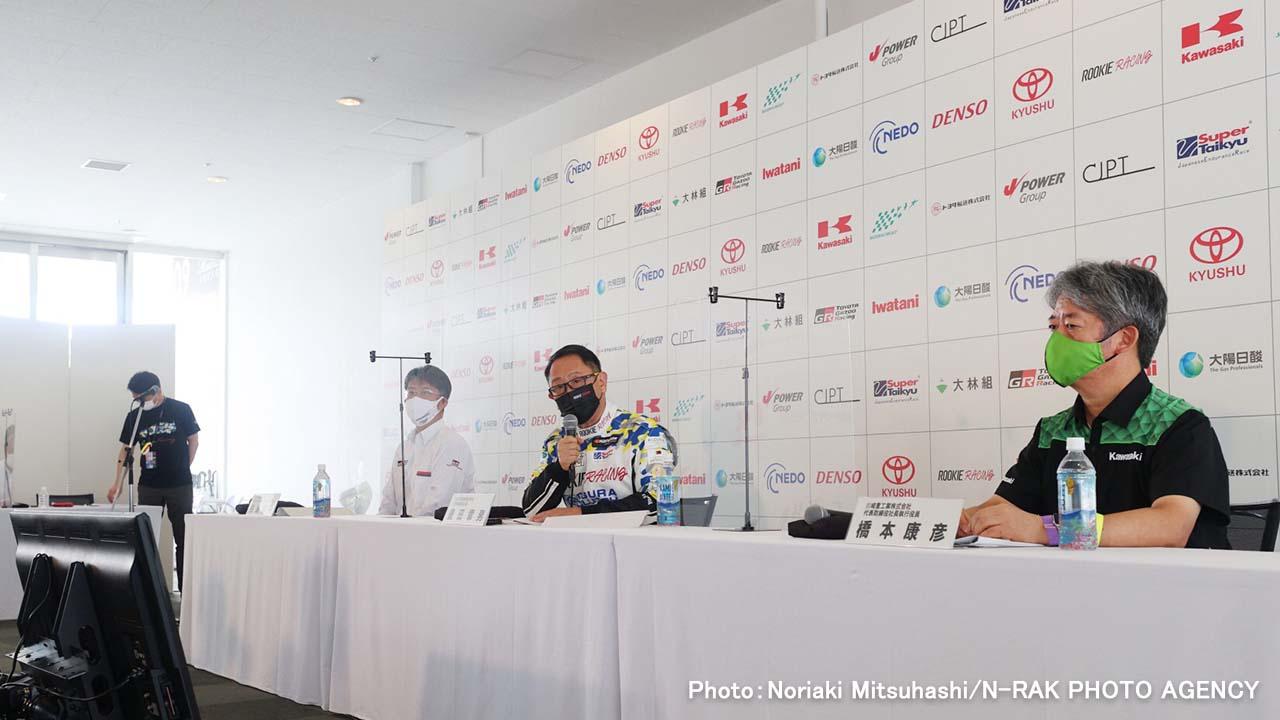
Toyota's endeavor with the hydrogen-powered engine has continued and seen greater progress each time. This time at Suzuka, from "major arteries" to "capillaries", transporting Australian hydrogen for the race brings new challenges to light.

On September 18-19, the Corolla Sport equipped with a hydrogen-powered engine completed the fifth round of the Super Taikyu Series at the Suzuka Circuit in Suzuka, Mie.
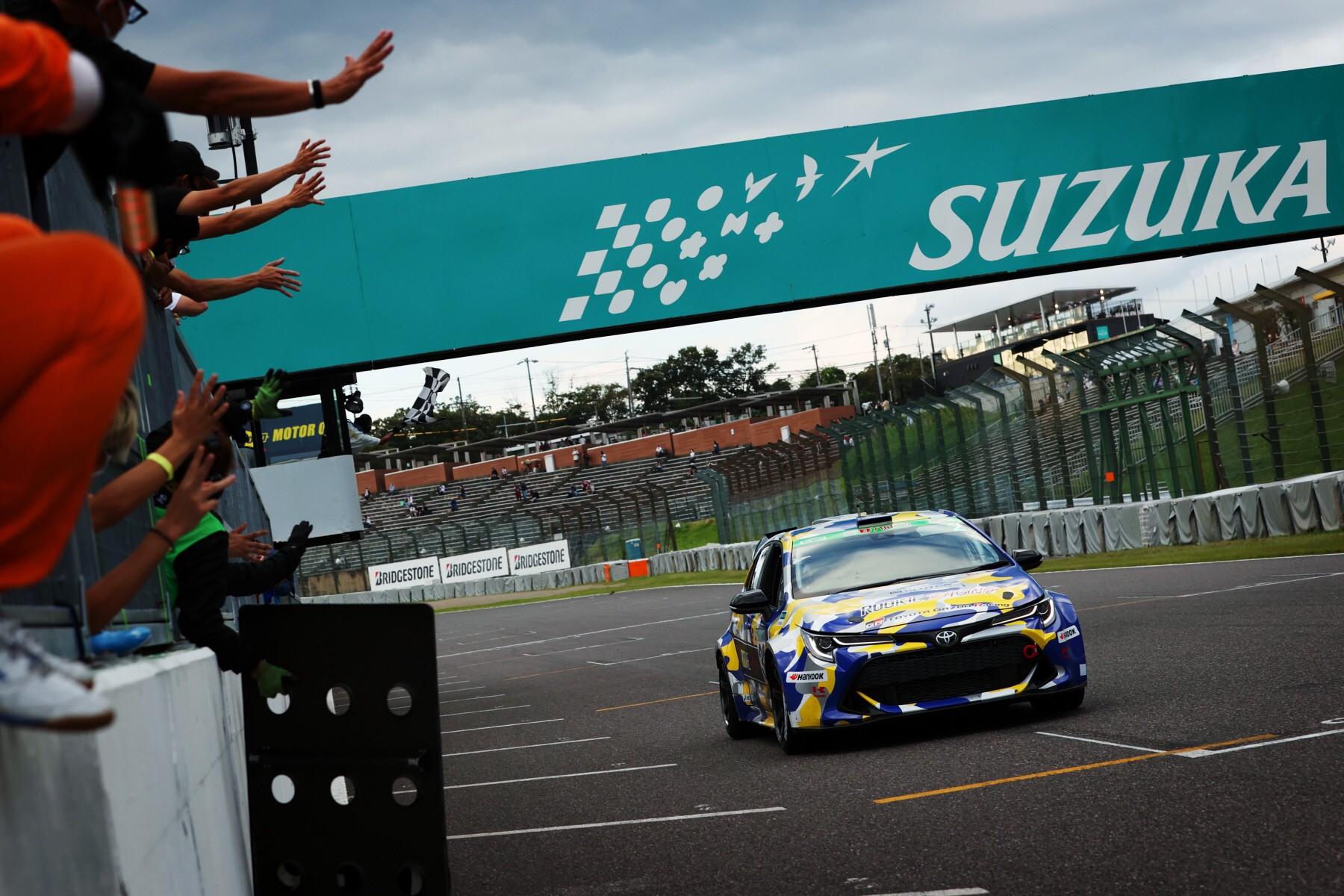
This race marked the third appearance for the hydrogen-powered vehicle. Toyota Times covers the event in two articles: Part 1, on expanding carbon-neutral options and the circle of like-minded partners with each race; and Part 2, on the car’s drastic evolution.
Moving towards hydrogen mass-consumption with new partners
At a press conference on September 18, the day of qualifying, President Akio Toyoda outlined the theme for this race.
Akio
These efforts (racing the hydrogen-powered Corolla) are intended to demonstrate more options in the era of carbon neutrality.
I regard the first race at Fuji Speedway (Oyama, Shizuoka) as a trial to expand options for the “use” phase in the cycle of making, transporting, and using hydrogen.
Race two at Autopolis (Hita, Oita) was about “making”, in which we used hydrogen produced from geothermal power.
This third race at Suzuka is about “transporting” and “making”, with hydrogen made from Australian lignite being transported to Japan.
Kawasaki Heavy Industries (which joined as a partner for this race) is also a member of the Hydrogen Utilization Study Group in Chubu, which seeks to establish supply chains for the mass-consumption of hydrogen in various fields besides automobiles, including chemicals and power generation, as part of efforts to create a hydrogen-based society in the Chubu region by 2025.
Encouraged by our efforts with the hydrogen-powered engine, Kawasaki took on the challenge of transporting hydrogen from overseas to Japan.
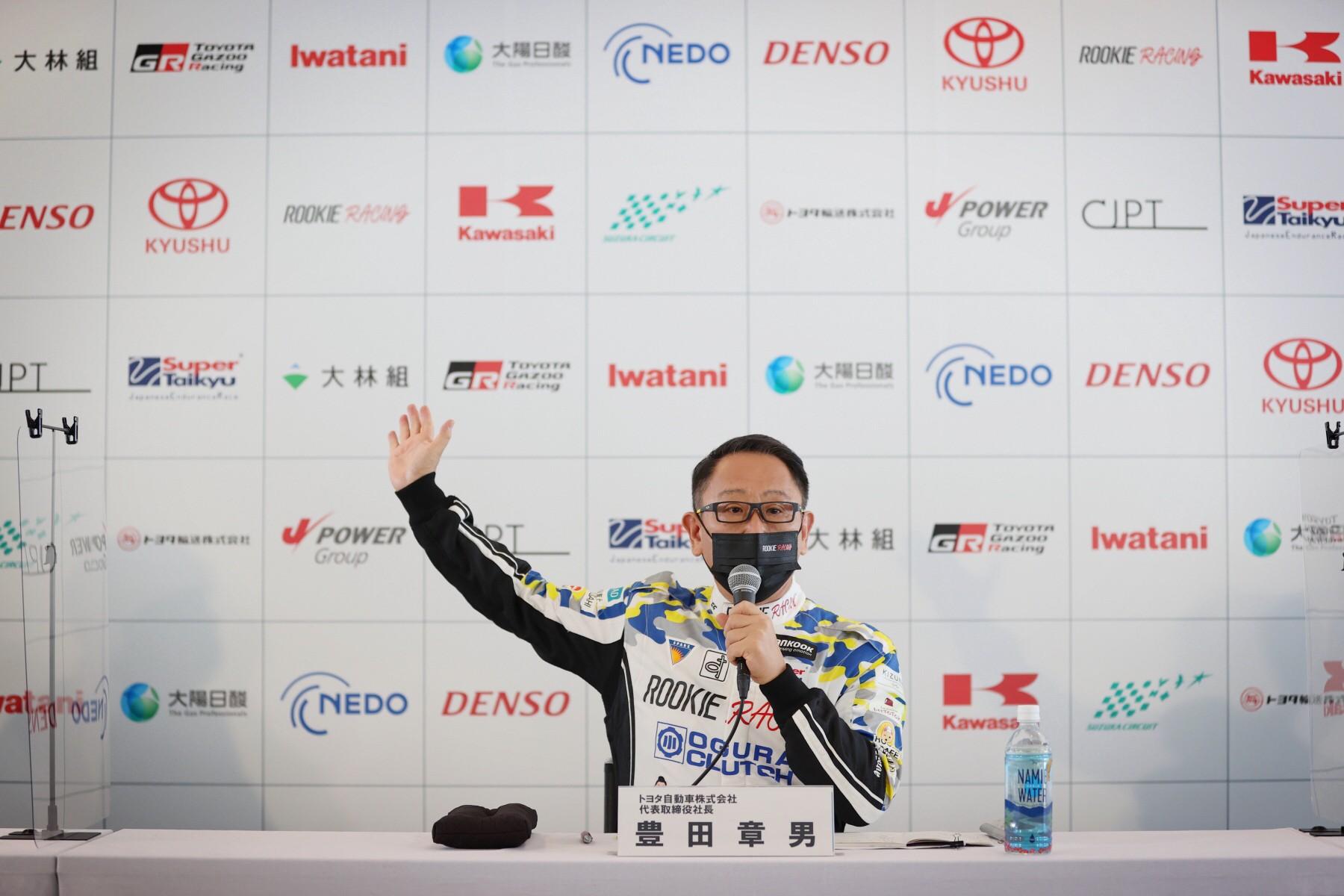
Pointing to the board behind him, Akio continued.
To begin with, this board behind me included far fewer companies when we started this challenge.
To bring hydrogen from overseas for this race, besides Kawasaki Heavy Industries, we received assistance from J-POWER (Electric Power Development) in purifying the hydrogen in Australia, and Iwatani Corporation, which then assisted with transportation.
We are also working on carbon-neutral hydrogen transport with light-duty fuel cell (FC) trucks prototyped by CJPT (Commercial Japan Partnership Technologies) and Toyota Transportation’s biofuel trucks.
For refueling, in addition to Taiyo Nippon Sanso and Iwatani Corporation, we’ve also received support from the local Mie Hydrogen Station.
As this panel shows, with each race, our circle of like-minded partners is growing through purposeful passion and action.
For the previous race, green hydrogen was produced locally in Kyushu, within the same region as the circuit, using geothermal and solar power to electrolyze water. One advantage of this approach was reduced CO2 emissions in the “transporting” process.
This time, the team used hydrogen transported all the way from Australia. While the approach is completely different from last time, such efforts are precisely what is needed to establish a full-fledged hydrogen-based society.
The “major artery” supplying hydrogen from Australia
Victoria, southeastern Australia. In the Latrobe Valley, 150km east of the state capital Melbourne, the natural resource lignite lies unused in abundance.
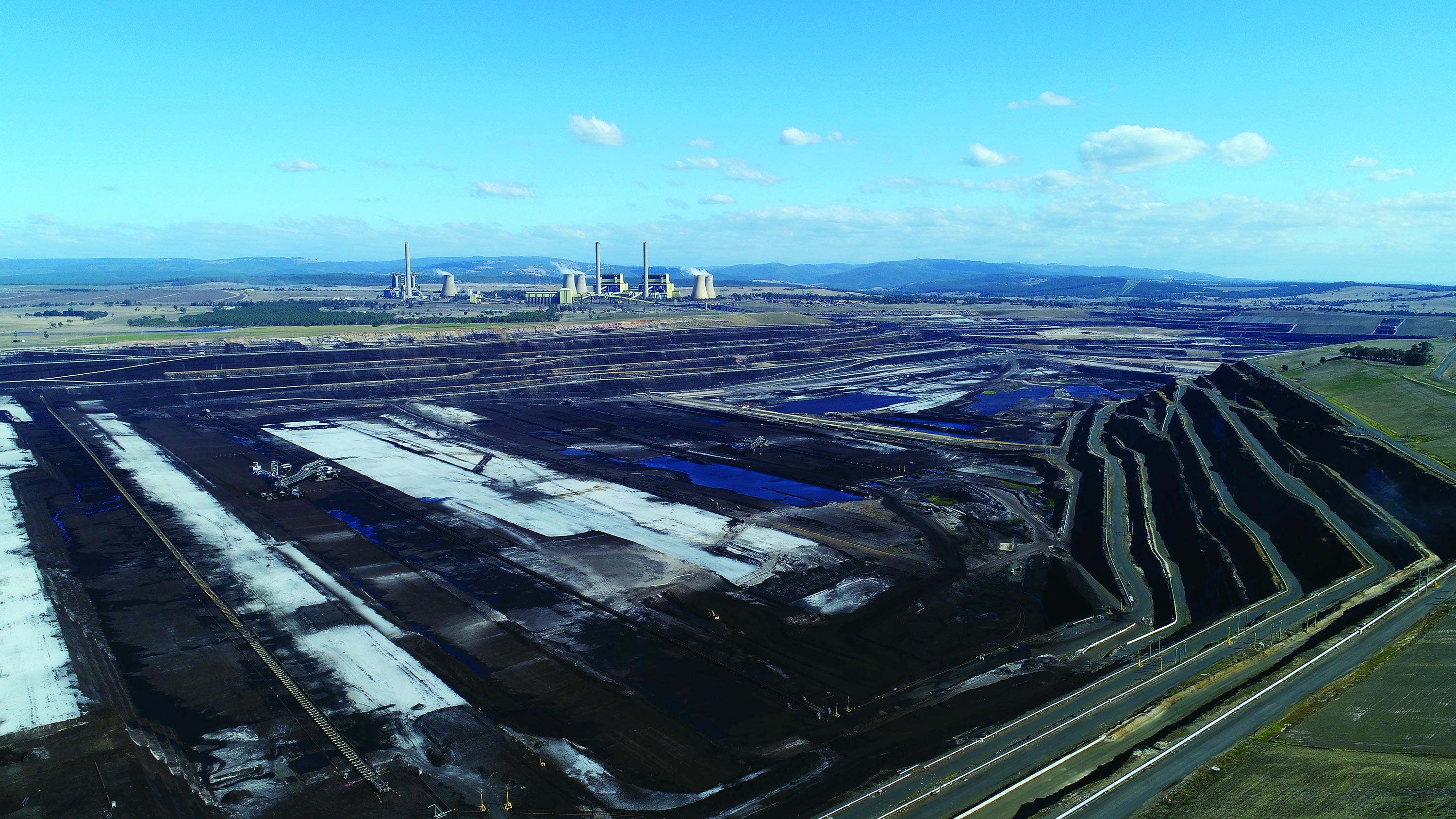
Lignite is young, low-grade coal. Heavy and bulky due to moisture and many other impurities, it also has a relatively low heat value. Dried lignite is also prone to spontaneous combustion, making transport difficult.
For these reasons, lignite costs around one-tenth as much as ordinary coal. Of the many ways to produce hydrogen, extraction from lignite* is regarded as one of the most economical.
*CO2 generated in the hydrogen production process is sequestered in the ground using CCS (Carbon dioxide Capture and Storage) to make the process carbon-neutral (which makes the produced hydrogen “blue hydrogen”)In addition, the lignite seams that stretch as far as the eye can see in the Latrobe Valley hold enough energy to supply Japan with electricity for 240 years.
This time, the process began with turning the area’s lignite into gas and recovering the hydrogen, which was then liquefied and stored before being transported by sea and unloaded in Japan. The various steps in this trial project were carried out by Kawasaki Heavy Industries, J-POWER, Iwatani Corporation, and the other private companies Akio introduced as like-minded partners, who worked with the Japanese and Australian governments.
As part of the project, by the end of this financial year Kawasaki Heavy Industries plans to transport hydrogen to Japan aboard its Suiso (which means hydrogen in Japanese) Frontier, the world’s first dedicated hydrogen carrier.
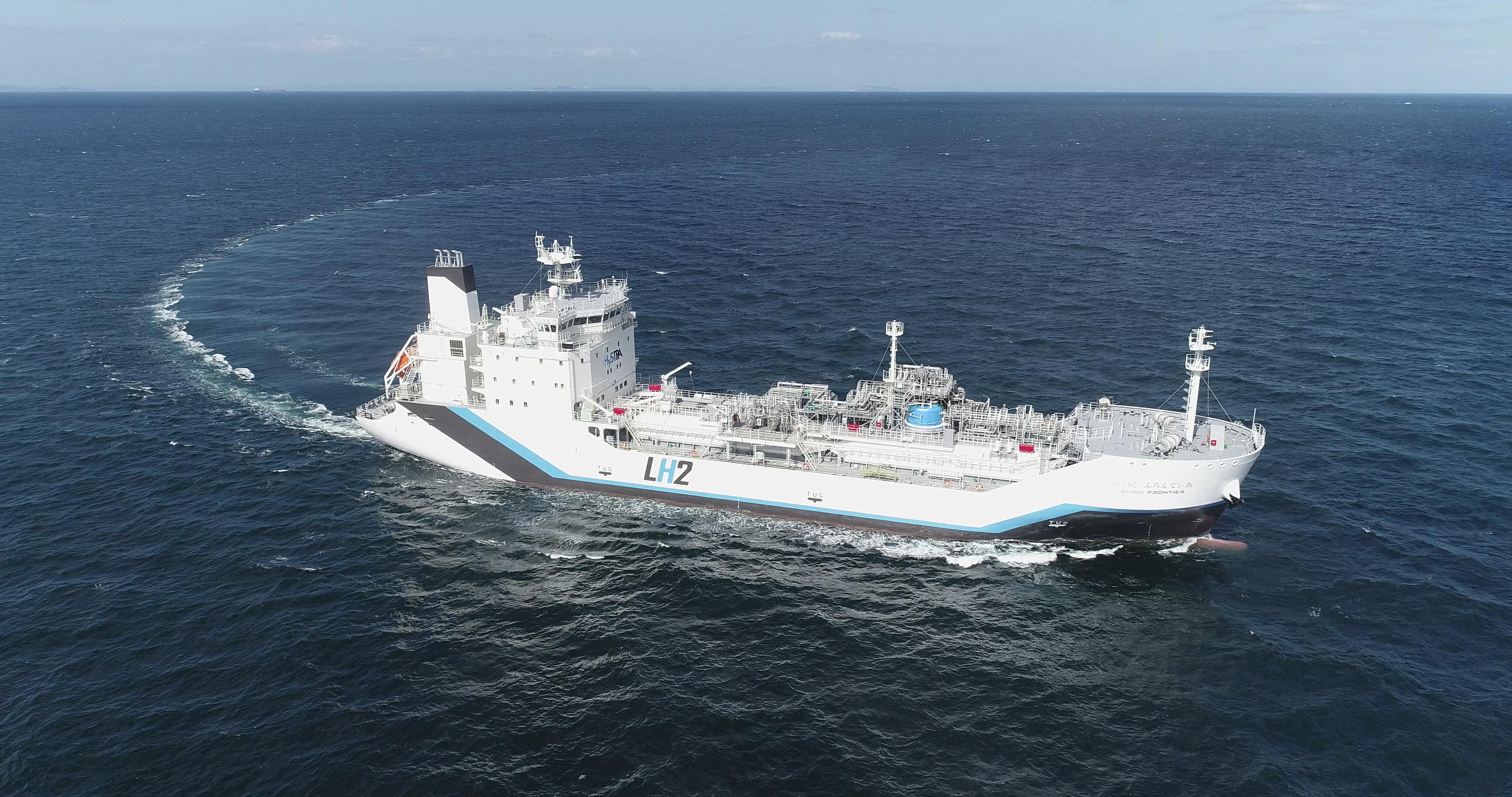
This vessel can carry up to 1,250 square meters of liquid hydrogen, enough to fuel 15,000 fuel cell electric vehicles (FCEVs). By around 2025, the company plans to have ships with 128 times that capacity. Cargo handling hubs will also be enlarged accordingly, reducing the cost of bringing in hydrogen. In other words, these efforts seek to create a “major artery” for supplying hydrogen.
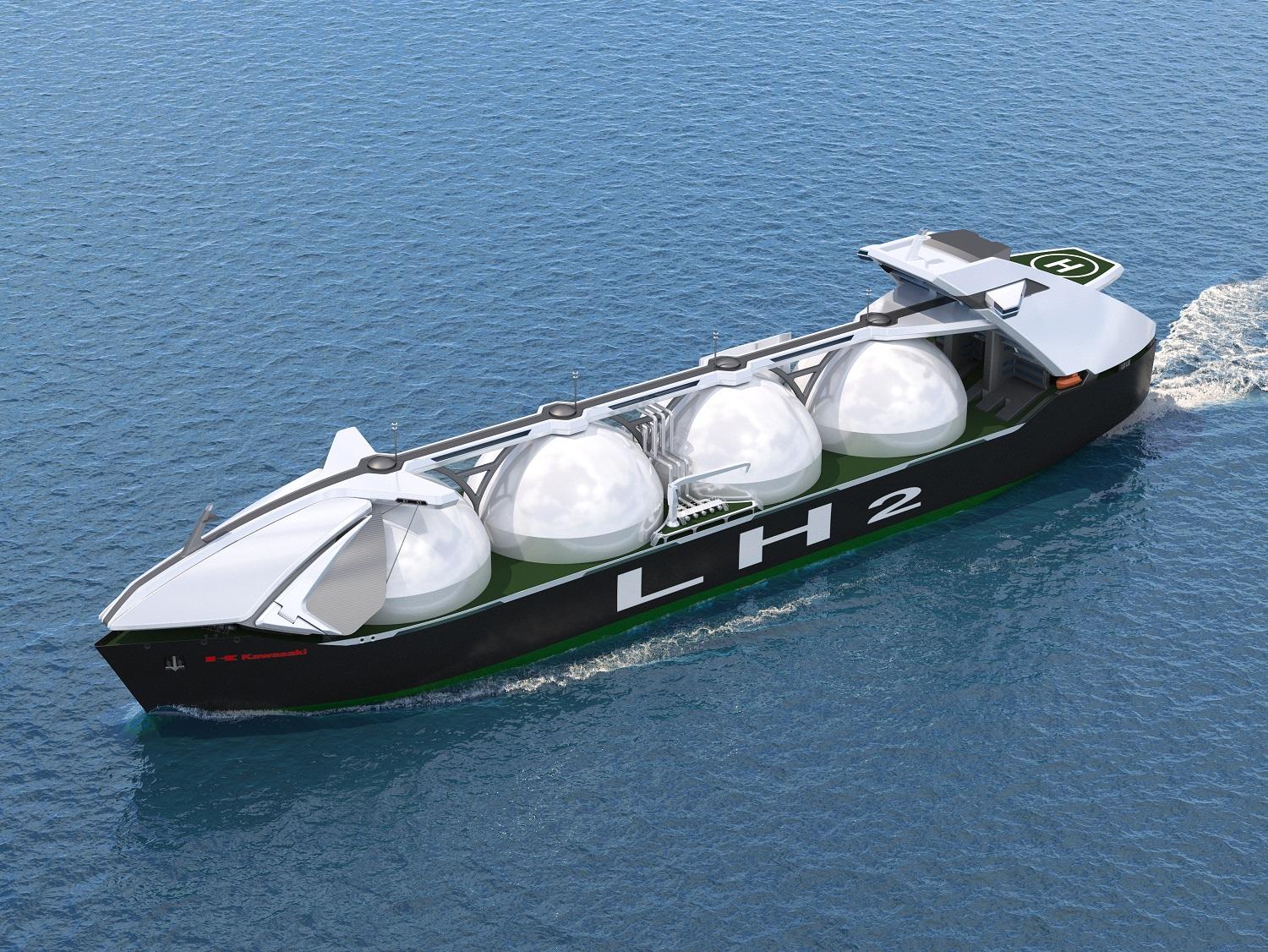
Per unit of habitable land, Japan actually consumes the most energy, and generates the most renewable energy in the world. Put another way, compared to Japan’s large amount of energy demand, there is not much room for a drastic increase of renewable energy generation within the country.
To achieve carbon neutrality by 2050, therefore, vast amounts of energy (resources) need to be brought in from abroad.
Lignite can be found not only in Australia, but all over the world. Given energy security concerns and the prospect of ensuring long-term supply, this resource presents a very promising option.
Hurdles to transporting hydrogen from overseas
Nevertheless, bringing hydrogen into Japan from overseas also comes with its fair share of challenges. The Deputy General Manager of Kawasaki’s Hydrogen Strategy Division, Motohiko Nishimura, explains.
Deputy General Manager Nishimura
Out at sea, shipping rules follow unified standards, but facilities on land rely on the rules of that country. These facility standards differ between Australia and Japan.
This time we put the Australian hydrogen into cylinders, which were repacked into curdles (devices that bundle gas cylinders) in Japan, but the transfer proved troublesome, with openings not aligning and other issues. That's where you come up against technology and regulatory barriers.
Looking at Japanese regulations from a global perspective, you find some that are very particular, or prescribe a very high level of safety due to the high population density.
For hydrogen to become widespread quickly, we need to create common interfaces and make sure that it circulates with common technology.
The global trend is also moving towards making regulations as uniform as possible to facilitate widespread use. As in Europe, I hope we can push various regulations to improve.
Challenges in hydrogen-carrying “capillaries”
If the efforts to bring vast quantities of hydrogen to Japan form the “major arteries”, the last-mile transport that takes this hydrogen to where it is needed around the country can be thought of as the “capillaries”.
For this race, transport to Suzuka was handled by Toyota Transportation and Commercial Japan Partnership Technologies (CJPT). Launched in March by Isuzu, Hino, and Toyota, CJPT aims to solve issues in the transportation industry and work towards creating a carbon-neutral society.
CJPT received the Australian-made hydrogen in Nagoya and transported it in light-duty FC trucks, while Toyota Transportation used biofuel-powered trucks to carry hydrogen produced at the Fukushima Hydrogen Energy Research Field (FH2R) in Namie, Fukushima. These efforts ensured that overland transport was completely carbon-neutral.
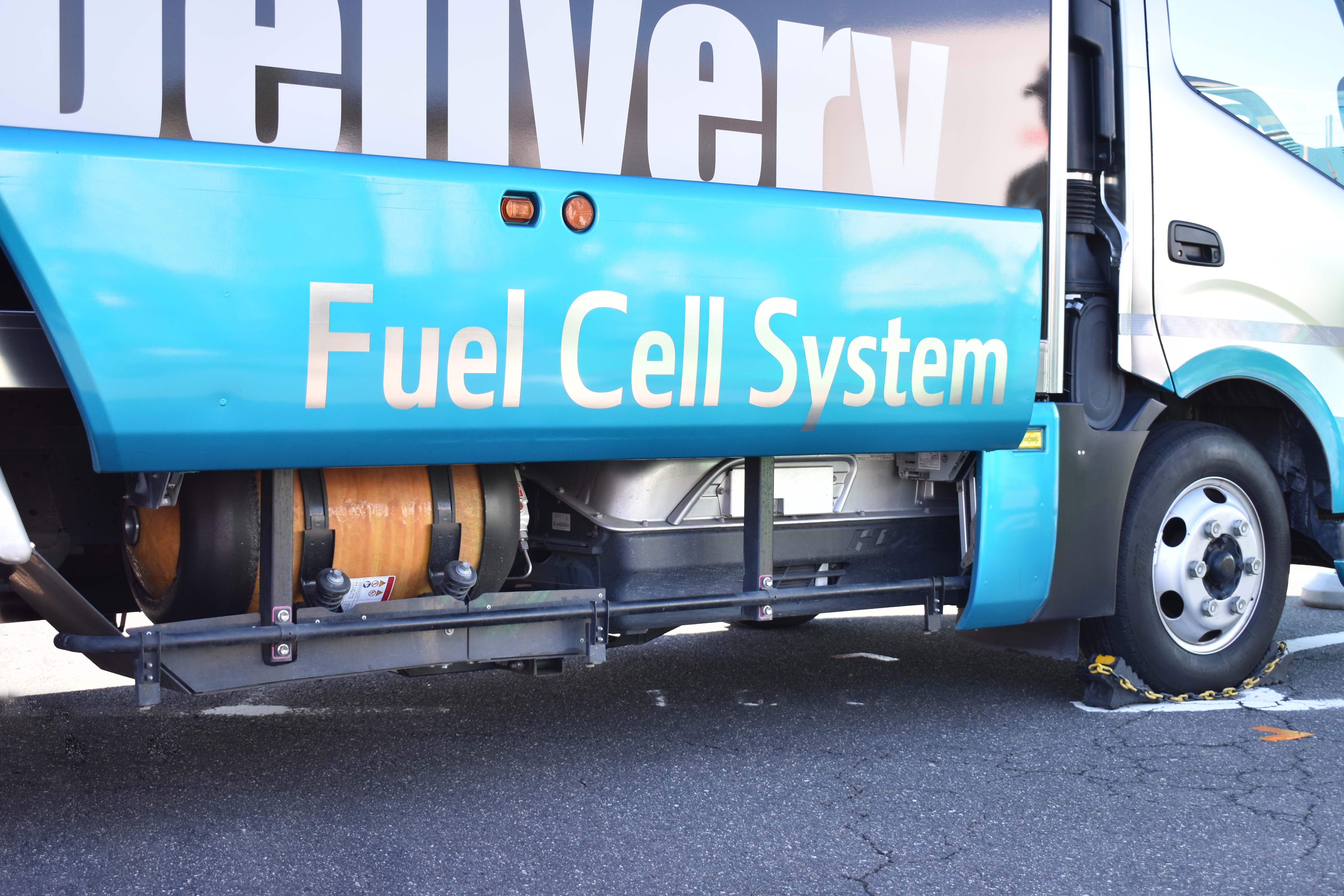
However, this endeavor brought several challenges to light. For example, the FC truck can carry up to 3 tons of cargo, but a curdle for transporting 15kg of hydrogen weighs 1.7 tons, meaning only one can be moved at a time.
On top of that, the 200km return journey between Nagoya and Suzuka requires 7kg of hydrogen fuel, inefficiently using up half of the hydrogen being transported.
Toyota’s CV Company* CVZ ZM Chief Engineer Hirofumi Ota, who personally drove the hydrogen-carrying light-duty FC truck, explained the challenges he noticed from the carrier’s perspective.
*In-house Toyota company mainly responsible for commercial vehiclesChief Engineer Ota
In a nutshell, we got there, but it wasn’t easy. The curdle was almost too big to fit.
To create a hydrogen-based society, the hydrogen needs to reach all sorts of places, down narrow alleys and in front of houses.
That was partly why we chose a light-duty truck, but (the cargo area) being so small meant that we needed three or four people to load the curdles, including a forklift driver, guides, and people to move the cargo area platform.
If that’s what it takes to make every journey, it’s not feasible to transport. For widespread use, we have to explore vehicle and curdle configurations that make loading easier. Given that logistics driver issues also come into play, we need to find ways to overcome this.
I think this approach (of utilizing hydrogen) will be adopted widely around the world only when “transport” can be done efficiently with few people.
CJPT President Hiroki Nakajima (Toyota in-house CV Company president) also mentioned the challenges highlighted through this project.
President Nakajima
Trucks also have a load allowance that is unrelated to the weight of hydrogen-carrying cylinders. Changing the regulations of either could allow hydrogen to be transported more efficiently and used more easily.
Technically, we could even cram more into individual hydrogen cylinders by raising the pressure. But safety standards and attitudes currently present an insurmountable hurdle.
The resin tanks (used in FCEVs), for example, can withstand higher pressures and hold greater volumes. I believe switching to these could improve efficiency.
When put that way, it sounds like I’m putting all the blame on regulations, but I think the kinds of usage that are assumed when determining safety factors need to be demonstrated technically.
From there, we can use real-world examples to present the standards that we believe should apply for a given environment, which can then be shared as common standards. I think it’s important for the people who set the standards and those who propose them to work together towards a solution.
We will continue to make FCEVs more efficient, and propose transportation methods. Along with the private sector, the government can also work to maximize efficiency. I hope this will help generate that momentum.
All of these issues may come as nothing new to those working in this field for a long time. But as a growing circle of like-minded people experiences “transport” firsthand and develops a shared awareness of the challenges, their voice will continue to grow louder.
The efforts to race with hydrogen-powered engines have illuminated the challenges involved in creating a hydrogen-based society, and spurred lively discussion. Nakajima expressed the effect in his own words.
Nakajima
Through racing, more partners have come on board, bringing more people into the discussion. If those talks stayed within Toyota, you cannot understand the genba reality.
When you talk to people who know that reality, you can see where the trouble really lies, and work together towards improvement. Being able to have these discussions also brings everyone closer together.
Shared purpose drives carbon neutrality
With each race, the circle of like-minded people grows, and discussions progress towards realizing a hydrogen-based society. The fact that this race charted a course for bringing vast amounts of hydrogen to Japan from overseas will surely make that society appear more real in the eyes of many.
At the aforementioned press conference, Kawasaki Heavy Industries President Yasuhiko Hashimoto shared the following words.
President Hashimoto
As President Toyoda has often said, I feel that it is very important to create partnerships among companies from various fields who share this vision and have the passion to continue taking concrete steps towards carbon neutrality.
Our mission is to produce hydrogen in vast quantities and supply it at affordable costs to Japan, but a hydrogen-based society is only set in motion when the supply side and the “use” side work together.
While expanding our supply chains, we’ve worked to bring more like-minded people on board. As we were wondering where the use would come from, Toyota took the lead in demonstrating hydrogen’s potential.
I’m sure that seeing the hydrogen-powered engine race, running under the most extreme conditions, has offered a ray of hope and strength not only to us at Kawasaki, but also to engineers throughout Japan.
While Toyota is currently leading the way, I believe that, rather than wait for the government to act, it is crucial that we work together to expand the potential of hydrogen.
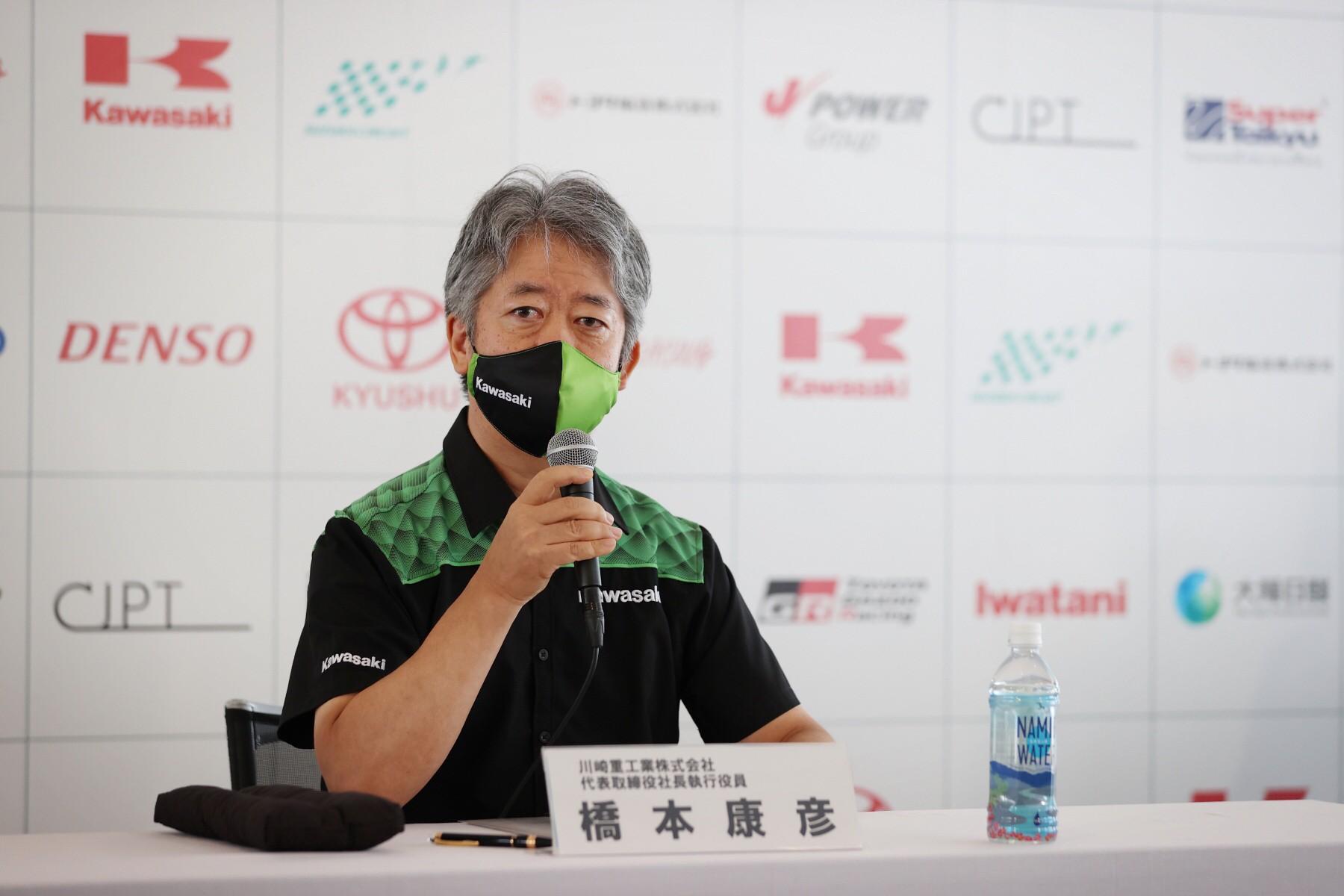
“Carbon neutrality should be driven by shared purpose”. These were Akio’s words when making his first hydrogen engine race appearance in May. Three races later, the circle of shared purpose grows ever larger.

